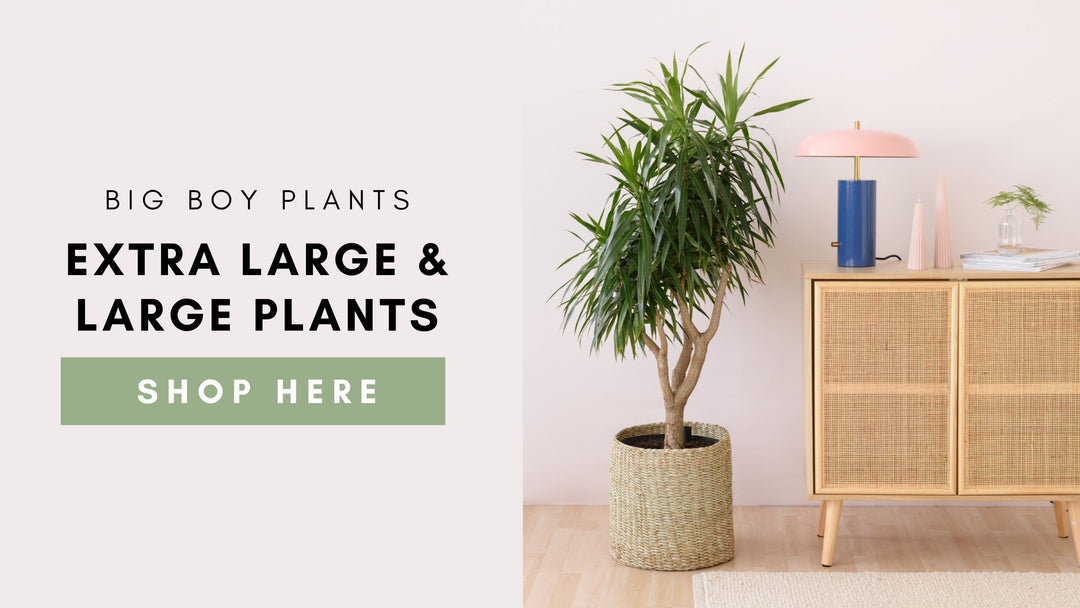CHEAT SHEET: General Plant Care

Caring for plants isn’t overly complicated, it just comes down to a few key elements done right. With a handful of good habits, your plants will be thriving in no time.
In this guide, we’ll help you avoid the most common care mistakes and share a set of easy, go-to tips you can rely on for looking after your houseplants successfully.
Let’s dive into our quick top tips below:

LIGHTING
-
Know your plant’s light needs
- Different plants thrive in bright, indirect, low, or direct sunlight.
- Check each plants' preference in our detailed A-Z Guides.
-
Observe natural light patterns
- Notice how sunlight moves through your space during the day, and at different seasons. Place plants accordingly.
-
Avoid sudden changes
- Moving a plant from low to intense light can shock it; acclimate gradually.
-
Rotate regularly.
- Turn plants periodically so all sides receive light and grow evenly.
-
Supplement if needed
- Light changes throughout the seasons; adjust plant positioning or supplement with grow lights, especially in winter.
-
Optimise lighting by keeping your plants' leaves clean
- Wipe leaves regularly with a soft lightly damp cloth to remove any dust blocking light.

WATERING
- Establish a regular schedule to check whether the plants need water; only water them if it is necessary.
-
Consider getting a Water Meter to guide your decision-making.
- Always water by effect, not timing!
- Check whether you need to water; if not, skip watering until the next scheduled check.
How to Check if Your Plant Needs Water:
-
3 Ways to Check if a Plant Needs Watering:
-
Look: is it drooping, or are the ends dry? Underwatering. Are there yellowing leaves? Generally overwatering.
Be mindful though, that yellowing can be part of your plant's natural cycle or caused by another symptom. - Weigh: Is it light (the soil has less water) or heavy (the soil is saturated with water)?
- Feel: the soil, 4-6 cm deep, Is it wet or moist?
-
Look: is it drooping, or are the ends dry? Underwatering. Are there yellowing leaves? Generally overwatering.
- Don't let plants sit in water; empty excess water out of pots and drip trays.
-
With Large plants, make sure to water effectively.
- Take to sink, balcony, etc.; soak them; let water run through a few times until all the soil is wet/moist.
- Note that the more soil you have, the more water retention, meaning longer periods of drying out = less frequent watering.
-
It is always easier to fix underwatering vs. overwatering.
- If in doubt, don't water! Read up more on Watering here >>
Seasonal Adjustments
-
Be aware that different seasons bring different conditions:
- Definitely, in winter/cooler months, err on the side of underwatering.
- Rather “tie a plant over” by “spot watering”, i.e., just enough, to avoid relative overwatering in cooler months.
-
Plants grow faster in the summer, using more water; be sure to check in more often than in the cooler months, but be mindful of just watering.
- Remember to assess soil before watering.

HUMIDITY
-
Know your plant’s humidity preference.
- Tropical plants often need higher humidity, while succulents prefer drier air.
-
Monitor indoor humidity
- Heating and air conditioning systems dry the air.
-
Watch for symptoms of low humidity
- Browning leaf edges, curling leaves, or slow growth can indicate the air is too dry.
-
Group plants together or use boosters
- Trays with water and pebbles, misting, humidifiers and strategic placement such as in bathrooms and kitchens, help raise local humidity.
-
Avoid sudden changes
- Keep plants away from drafts; open doors and windows.
- For more on managing humidity, check out: The Ultimate Guide to Humidity for thriving houseplants.

CHECKING PLANT CARE SYMPTOMS
-
Build a culture of "plant awareness" - not just on the water-checking day.
- If you notice something - drooping, yellow leaves - this might indicate that attention is needed.
- Pests hide on stems, in crevices and under leaves. Check regularly, especially if you notice discolouration and leaf deformity.
- Take photos of the plant to compare against if you need support in tracking changes in the condition of the plant.
- Early interventions and prevention related to care are better than waiting.
-
Check in with us if any issues arise.
- Check the List of Symptoms for each plant.
-
If you notice symptoms, don’t panic or overreact by watering more; check in on symptoms and manage accordingly.
- Rather set up a regular care regime; once the issue has been identified and managed, the plant will settle and start growing normally again.

FEEDING
-
Be sure to feed your plants over time to keep them healthy
- Here's a guide on fertilising >>
-
Top Tip: The faster the plant grows, the more regularly you feed. i.e., every 2 weeks.
The slower it grows the less you feed it, i.e. once a month.
-
It is best to only feed from spring through summer
- Light winter feeding is only required if the plants are still actively growing.
- Light winter feeding is only required if the plants are still actively growing.
- Check out our Guide on choosing the best fertiliser for you and your plants' needs >>

REPOTTING
When to repot or upsize?
Upsizing = Plant needs more space to grow.
Repot = Plant stays in the same container to manage size, but soil is refreshed.
-
Upsize every 1–2 years (on average)
- Most plants benefit from a refresh in this timeframe, though slow growers can go longer.
- Repot only if the soil has a sisease or needs a refresh
-
Best season is spring/early summer
- plants are actively growing and can recover from root disturbance more easily.
-
4 Signs it is time to upsize
- If roots are growing through drainage holes or circling tightly inside the pot, it’s time.
- This occurs when the soil dries out too fast, stays soggy, or appears compacted.
Repotting with fresh soil can help. - Growth slowdown: if a normally thriving plant seems stunted despite good care, it may need more root space or new nutrients.
- The Plant keeps toppling over: This means the plant is about 3 time bigger than it's container and needs a larger more stable environment.
What to do when repotting or upsizing:
-
Choose the right pot size
- Only increase the pot diameter by about 3–5 cm; too big a jump can cause overwatering issues.
-
Refresh the soil
- Replace as much old soil as possible with a fresh, high-quality potting mix suited to your plant.
-
Loosen the roots
- Gently tease out any roots that are circling the rootball to encourage new growth.
Be careful; some plants like Ficus and Peace Lilies do not like their roots disturbed; avoid messing with their roots.
- Gently tease out any roots that are circling the rootball to encourage new growth.
-
Water lightly after repotting
- Rather repot a dry plant
- Water lightly; let the plant settle and the roots adjust to the new soil.
-
Reduce stress
- Keep the plant in similar light and temperature conditions for a week or two after repotting to minimise shock.
Need help repotting? We've got you! Check out our services here.
- Here is another wonderful guide to caring for houseplants: Beginner's Guide to Plant Care
HAPPY PLANT PARENTING!!!!




